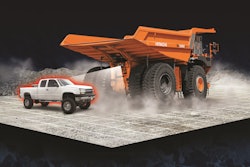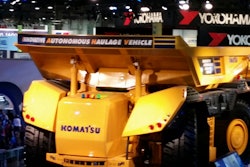
Speaking at the company’s Xploration Forum in Eskilstuna, Sweden, last month, Martin Weissburg, president, Volvo Construction Equipment, cited the explosive growth in autonomous vehicles as one example of the dynamic changes society is experiencing related to technology. “It’s predicted that by 2025, 10% of all cars in the U.S. will be driverless,” he noted. “Tesla, Uber, Google and Apple are all putting significant increased resources into autonomous vehicles.”
He indicated Volvo is poised to leverage the resulting developments and apply them to the industry segments it serves. “We’re able to take these technologies that are being developed, not just within companies like ours but around the world right now, and leverage them to make sure that we are then advancing,” Weissburg stated.
As evidence, the forum included a demonstration of Volvo’s own developments in autonomy in the form of a wheel loader, articulated hauler and cab-less load carrier. The prototype concept machines shown are scheduled to be shipped to customers for testing in real-world work environments.
Volvo CE “Xplores” Advances in Autonomous and Hybrid Technology
Of course, Volvo is not the only industrial supplier focused on autonomous technology, as the show floor at MINExpo 2016 in Las Vegas illustrated. Mining equipment suppliers have long heralded autonomy as a promising solution to enhance productivity and safety, and at the show, both Komatsu and Hitachi highlighted new autonomous technology for their large haul trucks. That said, Volvo appears to be the first to show the technology on traditional construction machines.
Komatsu Unveils Dedicated Autonomous Haul Truck at MINExpo
Hitachi's Technological Innovations on Display at MINExpo
But while autonomy is under development for prospective construction use, operators have little cause for concern about job security just yet. Practical application of autonomous machines on construction sites remains a ways off.
The high-production, repetitive tasks found on mining and quarry sites lend themselves to driverless systems. Construction projects, on the other hand, are more complex and varied in design and scope, and often involve unpredictable work environments. This presents significant challenges to implementation of full equipment automation.
Still, technology is advancing at a startling pace, and the prospect of autonomous machines on construction sites is a distinct possibility long term. When this happens, the role of the operator will need to evolve along with the equipment.
Jenny Elfsberg, director of emerging technologies, Volvo CE, likened it to the changes that have taken place in the manufacturing sector. “Nowadays in industry, they need to have education to operate the equipment in the factory. Our industry is facing the same changes,” she commented.
She implied the changes can be a win-win scenario. Operators benefit by removing them from performing dangerous or repetitive tasks and freeing them “to do something a little bit more intellectually demanding.” For the company, there is the prospect of addressing critical worker shortages. “In the future, you could potentially have one operator for three or four machines,” said Elfsberg, “increasing productivity and further decreasing costs.”




![[VIDEO] Embark Self-Driving Semi Truck Demonstration](https://img.forconstructionpros.com/files/base/acbm/fcp/image/2017/02/default.58b492405caa4.png?auto=format%2Ccompress&fit=crop&h=167&q=70&w=250)














